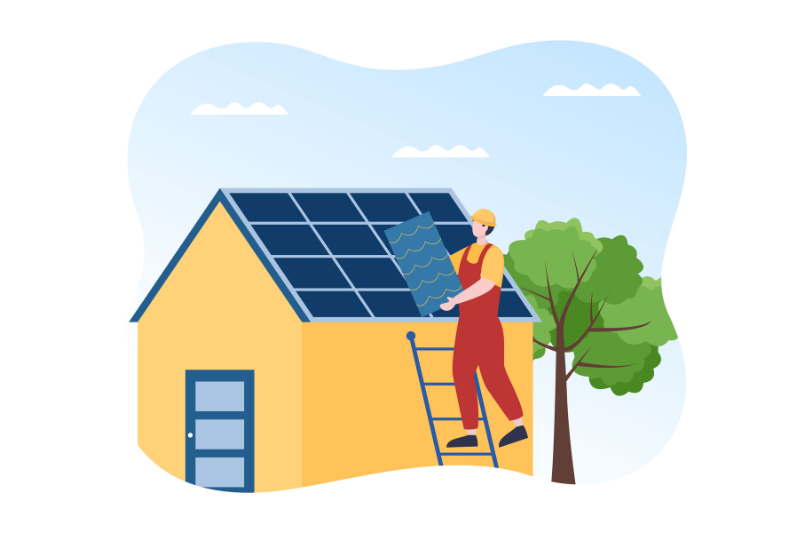We are more aware of the planet’s dangerous state of health than before. Our emphasis has shifted away from fast fashion and fast food to favour a more environmentally conscious way of life. This article will examine sustainability and how to achieve it.
Want to make your home more sustainable but need help figuring out where to start? Look no further. Here are the top 7 ways to make your home more sustainable in Australia.
But before that, let’s know some basics about sustainability and eco-friendly living.
What Is Sustainability?
Sustainable living entails living with the Earth’s resources in mind and using them responsibly so that our children live a healthy and prosperous life.
We should rely less on fossil fuels and reduce our carbon footprint. To keep our home balanced, we should use less energy, water, gas, electricity, or any other resource.
Sustainability means using social, economic, and natural resources without compromising the needs of upcoming generations. Sustainability includes more than just environmental issues. It also considers economic development and social balance.
Its primary objectives are as follows:
- Creating healthier environments for the creatures that live on the planet’s landmasses
- Creating healthier environments for the animals that inhabit our rivers and oceans
- Ensure better air quality
- Combating Climate Change
- reducing global poverty and hunger
- Improvements in education and economic growth
What Are Different Types Of Sustainability?
Environmental Safety
It is the most critical and urgent pillar of sustainability for many people. Our bias for convenience and heavy reliance on fossil fuels are resulting in millions of tons of landfill waste, harmful gases, and polluted groundwater.
Sustainability for environmental protection means walking short distances instead of driving. Also, to reduce the intake of single-use plastics and invest in higher-quality clothing to minimise material waste.
Economic Advancement
Social Balance
It is the most multifaceted sustainability pillar, focusing on a broader world perspective. It includes global physical health and how businesses’ reliance on harmful fossil fuels can affect it. Education is also a component of the social equity pillar.
Educating people about their daily choices makes them live sustainably. Social cooperation, improved health, and education increase people’s likelihood of making the world healthier. In this case, social equity prioritizes globalization over individualism.
Human Sustainability
Benefits Of Environmental Sustainability

Sustainability has numerous advantages for both businesses and individuals. There are always changes we can make as individuals to live more sustainably while saving money. Repurposing, recycling, and reusing items at home can be simple, practical, and environmentally responsible.
Sustainability extends beyond what we do with what we already have. Buying sensibly often means only buying what we need and investing in higher-quality, longer-lasting products when we do.
Sustainability improves public health while saving money on healthcare every year. It prioritizes providing for future generations over thinking about people’s fast-paced lives today.
How Does Sustainability In Environmental Protection?
Sustainability is not only beneficial to the environment; it is critical to the planet’s future. Individual, community, and corporate sustainability allows us to slow the environmental damage we cause.
Sustainability leads to a reduction in overall energy consumption. Wind and solar energy require less transportation than fossil fuels, and both options leave the surrounding areas relatively untouched.
Sustainable living and business operations result in less waste, less pollution, and lower overall operating costs.
Australia is a country with natural beauty and a rich biodiversity. However, the country faces environmental challenges due to rapid industrial and urban development. This has resulted in increased greenhouse gas emissions and depletion of natural resources.
But now we can easily play a role in minimising our environmental impact by adopting some simple activities. And making our homes more sustainable is one of the essential steps. With that in mind, here are the top 7 ways to make your home more sustainable-
Getting Solar Panels

In our previous blogs, we have mentioned switching to solar panels several times. If you want to achieve sustainability, there’s no alternative to solar energy. You can reduce dependence on non-renewable energy sources by harnessing the sun’s power.
It is one of the most effective ways to make your home more eco-friendly while lowering energy bills.
Many panels are available in various sizes. And you could even install an entire roof made of building-integrated photovoltaic shingles. These PV panels or shingles generate electricity from sunlight.
These panels can power your home during the day and, if combined with a battery system, can also power your home at night.
Install A Smart Meter
It’s easy to leave the heating on longer than necessary, especially during the colder months. As homeowners or renters, one of the most significant sources of energy consumption is through our boilers and home heating systems.
The best way to deal with energy usage is to consider buying a smart meter for your home. With these smart devices you can program and operate them remotely.
So they could heat your house before you enter the home or turn it on briefly before you get up in the winter.
If you are concerned about your carbon footprint, getting a smart meter is the best option. It can be an excellent way to keep track of your overall electricity consumption.
Use environmentally Friendly Cleaning Products
The cleaning products you use at home can harm local ecosystems. Standard cleaning chemicals are ammonia, various dyes, chlorine bleach, petroleum-based organic compounds, and microplastics.
These are highly harmful to local water systems and affect home air quality.
Instead, opt for all-natural, organic cleaners that don’t harm the environment. Such as vinegar- and baking soda-based cleaners, essential oil-based soaps, and eco-friendly dish soaps.
These gentle cleaners are safe for your family and environment. They are harmless to children and pets. It also provides a way to clean your home without leaving chemical residue on your cooking surfaces, causing health problems.
Purchase Energy-saving LED light bulbs
Energy-saving LED light bulbs have been around for a while. But recently, Australians have become more educated about their effectiveness. And how these bulbs save money all over your house.
There were many complaints about how companies should need to produce more light. Technological advancements are constantly happening. And now is the perfect time to switch.
LED bulbs are energy-efficient, long-lasting, and cost-effective. By switching your old traditional bulbs with LED bulbs, you can minimise your energy consumption by up to 80%.
These bulbs not only use less electricity but also don’t require replacing as frequently as traditional light bulbs.
Composting And Recycling
Plastics are a significant polluter of the environment. Single-use plastics take about a thousand years to decompose. Approximately eight million metric tons of these wastes are dumped annually in the world’s oceans.
Composting is the best way to reduce landfill waste and create natural fertilizers. It requires minimal effort and resources. Just Collect your food waste and other organic wastes like leaves and grass clippings, and compost them in a bin.
These harmful items kill an estimated one million animals and fishes annually. Some of these microplastics are also making their way into our food.
However, plastics are not the only materials that must be reused. Wastes that are biodegradable and non-biodegradable should be handled in the following ways:
Composting: Food scraps are frequently thrown in the rubbish. It can enrich the soil in your garden. Some ordinary compostable kitchen wastes are vegetable and fruit peels, eggshells, and coffee grounds.
Recycling: Instead of throwing non-biodegradable items in the rubbish, turn them into decorative items to keep them out of crowded landfills and smoke-producing incinerators.
Switch To Energy-saving Home Appliances

Some environmentalists would prefer eliminating significant home appliances and doing chores without electricity. But it’s only feasible for a few homes regularly.
As a result, consider purchasing appliances that use inverter technology to ensure that they do not require excessive energy consumption.
Energy-efficient appliances such as fridges, ACs, and washing machines can save electricity bills and reduce greenhouse gas emissions. Look for appliances with high-star energy ratings to ensure optimal energy efficiency.
Buying appliances with energy-saving features, such as refrigerators, air conditioners, and washing machines, may be costly, but it can help you save money in the long run.
Upgrade Your Windows And Doors
According to studies, your windows may be responsible for at least 50% of your home’s lost energy. Window gaps allow heating or cooling to get out. And overall, energy management could be better.
If your electricity bills continue to rise despite no changes in consumption, you may have a problem with your windows.
Replace or upgrade your windows and doors with energy-saving procedures such as double glazing, special coating, non-conductive window frames, and sealing. Weather stripping installed around these fixtures can also help your home become more energy-efficient.
Some Extra Ways To Achieve Zero-waste
- Choose sustainable building materials.
- Reduce water usage with a smart heat pump.
- Install low-flow shower heads and faucets.
- Reduce, Reuse, Recycle, Upcycle.
- Choose sustainable transportation
By making these simple changes, you can do your part in creating a more sustainable future for Australia and beyond.
Start small, and soon, you’ll be well on your way to a more eco-friendly lifestyle. Solar Emporium will support your sustainable living throughout. Use these top 7 ways to make your home more sustainable in Australia.
In conclusion, making your home more sustainable can seem daunting, but it doesn’t have to be. Implementing these simple steps can contribute to a greener and more sustainable Australia. Let’s do our part to preserve our country’s natural beauty for future generations.







